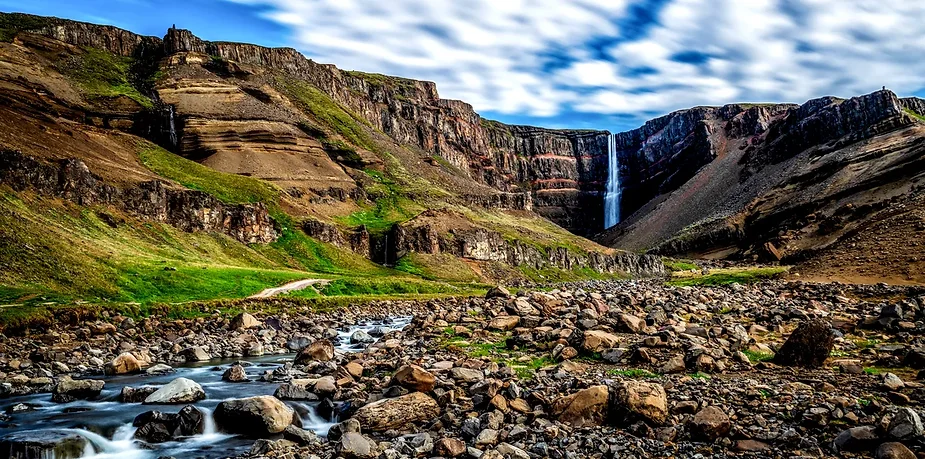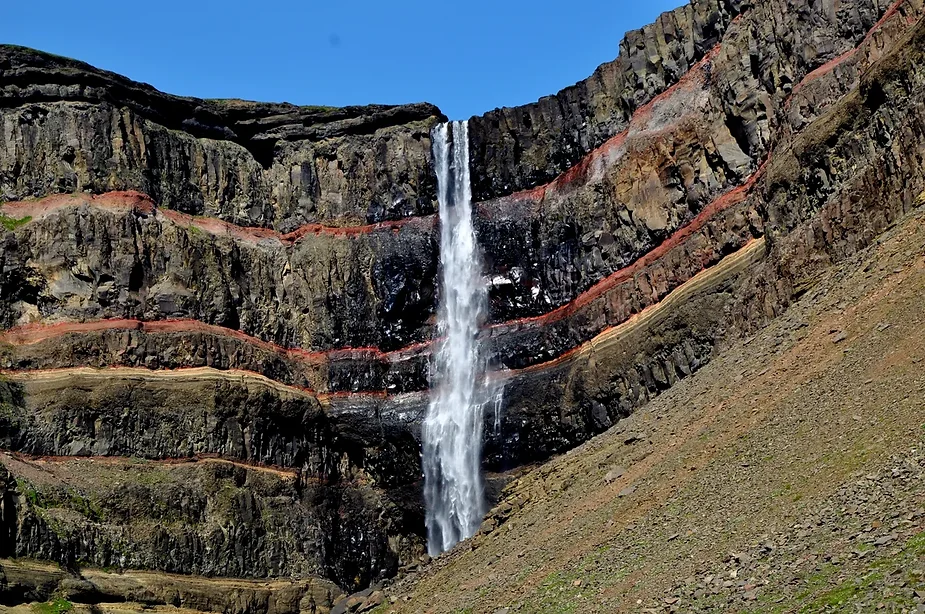Layers of Time at Hengifoss Waterfall: Iceland’s Geological Masterpiece
Nestled in the eastern highlands of Iceland, Hengifoss Waterfall isn’t just a natural wonder—it’s a living geological record that tells the story of Earth’s tumultuous past. With its dramatic 128-meter (420 feet) plunge, Hengifoss is one of Iceland’s tallest waterfalls, drawing travelers from around the globe to witness its striking beauty and the fascinating layers of history embedded in its cliffs.
The Geological Marvel of Hengifoss
Hengifoss stands out not only for its stunning height but for the unique geological formations that frame its cascading waters. As you stand at the base of the waterfall and gaze upwards, the striking red and black basalt layers are impossible to miss. These colors aren’t just aesthetically pleasing—they’re a visual record of Earth’s volcanic activity over millions of years.
The red streaks are clay-rich sediments that were trapped between layers of basalt lava, which erupted in stages over countless millennia. The contrast between the dark basalt and vibrant red sediment layers offers a rare, natural glimpse into the Earth’s history, providing clues about volcanic eruptions, sediment deposition, and the geological forces that shaped the landscape we see today.

A Window into Iceland’s Volcanic Past
Iceland, often described as the “Land of Fire and Ice,” is a country defined by its dramatic volcanic landscape. The volcanic activity that formed Hengifoss occurred over millions of years, with eruptions shaping not just this waterfall but much of the island itself. The red and black layers visible at Hengifoss are made up of basalt lava flows interspersed with sediment layers, giving the area its distinctive geological features.
The story behind these layers begins long before Hengifoss came into being. As volcanic eruptions spewed lava across the region, ash and clay-rich sediments were deposited in between the lava flows. These sediments came from both volcanic material and ancient bodies of water that once existed in the region, offering a glimpse into a time when the environment was vastly different from what we see today.
As the years passed, tectonic activity lifted and shifted these layers, exposing them along the river gorge where Hengifoss now tumbles down. The result is a stunning natural display that acts as a geologic timeline, where each layer marks a chapter in the ongoing process of Earth’s dynamic history.
Hiking to Hengifoss: A Journey Through Time
Reaching Hengifoss is an adventure in itself. A popular hiking trail leads visitors through the rugged terrain of eastern Iceland, offering spectacular views of the surrounding landscape, including smaller waterfalls like Litlanesfoss along the way. The trek to Hengifoss takes about 1.5 to 2 hours, depending on the weather and your pace. The hike is moderately challenging but well worth the effort, as the stunning views of the waterfall and the geological layers are truly remarkable.
Along the trail, you’ll be walking through an environment that seems to pulse with ancient energy. The vibrant red sediment layers are particularly striking during the summer months when the landscape is lush and green, contrasting beautifully with the rocky outcrops and basalt formations.
The rewarding view at the end of the trail is nothing short of breathtaking. As the water plunges down the 128-meter cliff, it creates a mist that adds to the ethereal beauty of the scene. Standing there, you’re not just witnessing a waterfall—you’re observing a dynamic process that has been unfolding for millions of years.

The Cultural Significance of Hengifoss
While Hengifoss is a geological wonder, it also holds cultural importance for Icelanders. The waterfall is located near the town of Egilsstaðir in East Iceland, an area rich in both history and folklore. According to local legend, the waterfall is linked to the myth of the “Skessuhorn” or “Troll Woman’s Horn,” a giantess who supposedly roamed the area. This blend of natural wonder and cultural mythology adds to the allure of Hengifoss, making it not only a must-see geological site but also an important part of Icelandic heritage.
Conclusion: A Natural Monument to Earth’s History
Hengifoss Waterfall is more than just a beautiful cascade; it is a geological monument that encapsulates millions of years of Earth’s history. The dramatic red and black basalt layers tell the story of volcanic activity, sediment deposition, and tectonic shifts that have shaped the island of Iceland. As you hike to the waterfall, you are not only rewarded with a stunning view but also with a rare opportunity to witness the passage of time etched into the landscape. Hengifoss is a reminder of the power of nature and the incredible forces that have sculpted our planet, making it an essential destination for anyone interested in the natural world, history, and the beauty of Iceland’s wilderness.
